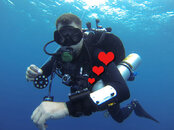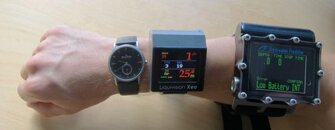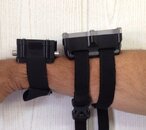The DG03 is at DGX now because they bought a boat load of them because lots of tech divers use them in gauge mode as backup computers, they bought a boat load at cheap prices, had the firmware upgraded, and are basically liquidating. I don't know where you're finding the TX-1 for $500 with the cable, but shame on you if you're taking that price without the computer trade in based on the honor system. If that is your mentality now, you won't last long in the diving world. It is very very small and small things like that echo loud and clear.
Another potential is the Seabear H3. It's a bit more expensive than the Petrel by about $100, and that one might actually be able to compete in this battle. Unfortunately it is a very small company out of Austria, and it hasn't actually been released yet. APD trusts them enough to be the HUD on the new Vision CCR so they are quite good and they are built like tanks, the T1 was built for the military and it will be interesting to see how the H3 stacks up. It looks sexy as hell though
H3
To Stuart.
regarding the compass, you said it yourself, you likely are pulling a compass out for general waypoints, not full out navigation, and if you are doing full out navigation, having the compass on a slate is a helluva lot more comfortable for long navs than having to keep your forearm perfectly perpendicular to your body and also means you are stuck looking mostly down instead of ahead of you. The slate video I linked before is perfect for most diving conditions because you can write down all pertinent info on it, draw a basic map of where you are diving so you don't get lost, i.e. on a wreck, draw the basic outline, mark where the anchor is, and orient it properly, and you'll likely never get lost, same with shore diving. Good thing to have, especially since you can communicate with it. Great tool and cheap. I'd be really grumpy if I had to nav off of something on my forearm for any distance. It's nice to have, it's cheap for the companies to put in if they want to, but it's not a selling feature I'd ever plan on using or justifying one computer or another because it has one or doesn't. The Seabear has one because it can actually tether to a GPS buoy on the surface for the military guys and is also designed for underwater combat swimmers that are parachuting to their landing zone, so integrating it in for that makes sense. For what normal people do, it's one of those "nice to have but will probably never use it" type things.
The A300 CS is about $100 more than the list price of a Petrel, about 1.5x when you add AI. It gains you nothing other than the ability to spend about $400-$500 when you decide to go AI, and with the price of a DG03 plus transmitter, if you really care that much about wireless AI, it's about a wash. Wireless AI is just a really expensive solution to a nonexistent problem....
Hey tbone, I am not buying a TX-1 or anything else right now. I don't own a dive computer yet at all, so I don't have anything to trade in for the TX-1. But, after seeing it in person, I personally have shied away from it and all similar sized PDCs because I don't like the idea of something so bulky.
That Seabear looks really cool but they haven't announced a price and won't be out for a while, right?
The price of the A300CS and the Petrel are both $950 from my local LDS. The A300CS seems to be $950 other places, too. And the Petrel seems to generally be $950, too.
As for compasses, you seem to be reinforcing my point. I.e. most of the time, for Rec divers - at least, ones on vacation resort dives - their compass is, at most, used to get a heading and then go. It's not used for full-time navigation. So, for the OP, why would he need any more of a compass than the electronic one in an A300CS or similar computer? I understand why Tech divers, combat troops, etc. would want a better compass, which then makes it pointless to have one in the PDC, but the OP is none of those. Neither am I, for that matter.
Other than that, saying the A300CS gains you nothing (compared to the Petrel) is saying that the smaller, less bulky size is of NO value. As well, the color-coded bar graphs on the sides. And, well, that may be true for you, but it's not true for everyone! I have been eyeing the A300CS in particular because it's so much less bulky than the Petrel. I don't have the money for either, so I'm just window shopping right now, not saying which one I would actually buy.






